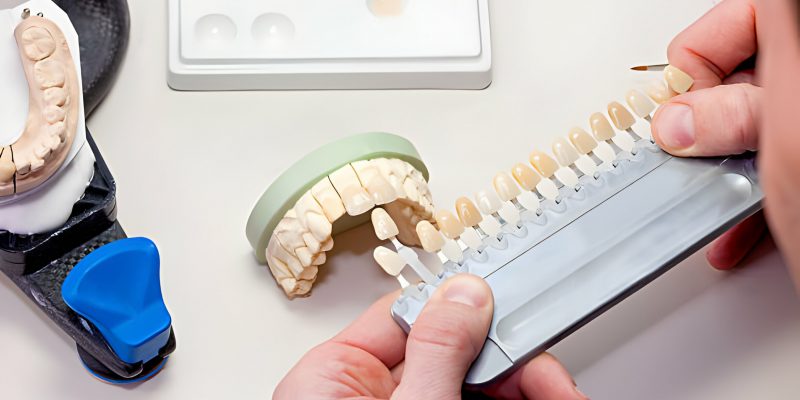Ever been in an unfortunate incident where you’ve chipped your teeth?

While you might consider yourself unfortunate, it’s more common than you think. Stats suggest that over 178 million Americans have chipped, broken, lost, or deformed teeth.
But does it mean you must avoid smiling for the rest of your life? No! This is where restorative dentistry procedures step into the picture. These procedures help you smile with complete confidence once again.
This blog takes a closer look at dental restorative procedures by understanding more about:
- More About Restorative Dentistry – What is Restorative Dental?
- When Do You Need Dental Restoration?
- Types of Dental Restorations Offered by Your Dentist
- Why Restorative Dentistry for Your Teeth?
Continue reading as we learn more about different aspects of the treatment in the following sections.
More About Restorative Dentistry – What is Restorative Dental?
Restorative dentistry, as the name implies, focuses on restoring damaged oral structures such as teeth and gums. The branch specializes in repairing and restoring damaged and missing teeth.
You may need this form of dentistry if you suffer from the following conditions:
- Cavities and dental decay.
- Damaged or fractured teeth.
- Missing teeth (falling off or being pulled by a dentist).

Other oral disorders, such as gingivitis, receding gums, and periodontal disease, are also treated with restorative dentistry. Some of the extreme oral issues fixed by this dentistry include extensive scaling, root planing, and cleaning.
Upon visiting your Aubrey restorative dentist, you’ll discover that implants, crowns, and bridges are the most commonly used oral restorations. It also covers teeth whitening, fillings, and bonds (the gluing or bonding of fractured teeth with a crown or denture).
When Do You Need Dental Restoration?
Dental restoration is necessary to restore the function and health of lost, damaged, or weak teeth. Here are some prevalent reasons why your general dentist may propose restoration:
Stains and Chips
Restorative dentistry can help you regain oral health. However, certain restorative procedures offer cosmetic benefits. Veneers, for example, are a thin coating of tooth-colored material attached to the teeth’ surface. It may cure tiny fractures and chips while improving your smile’s look.
Tooth Decay
Fillings are the most prevalent type of dental repair. They aid in curing enamel erosion. Decay occurs when your tooth is exposed to acidic chemicals that erode the outer coating, known as enamel. It exposes the dentin layer (the softer inner layer), which might result in a cavity. A cavity can lead to decay, discomfort, infection, and tooth loss.
Damaged Structure
A fractured enamel cannot heal independently because, unlike bone, it lacks a blood supply. A tooth with significant injury may have compromised structure. Therefore, professionals suggest restorative dental procedures to rebuild the structure.
Missing Teeth
Tooth replacement is a popular type of oral treatment. If you are missing one or more teeth, you can replace them with implants. It will restore the functioning of your cavity while improving your smile.
Types of Dental Restorations Offered by Your Dentist
Fillings, crowns, and dental bonds are among the most common restoration methods professionals use. However, the ones they suggest depend on several factors.
Keeping the same in mind, this section closely examines different oral restorations a dentist offers.
Fillings
Tooth decay occurs when plaque forms uncontrolled on surfaces. This film comprises bacteria, starch, and carbohydrates, which create acidic waste. This acid eats away at the minerals in your enamel.
When enough enamel erodes over time, cavities appear on your teeth. Smaller cavities can be filled with oral fillings, much as cement or asphalt can be used to repair potholes on the pavement. This surgery includes drilling out the decaying area of the tooth.
To disguise the hole, your dentist in Aubrey, TX, will fill it with composite material that matches the color of your tooth. It halts the growth of decay and minimizes the chance of future injury.
Crowns or Caps
Dental crowns are a form of denture or tooth replacement that fills bigger cavities or restores a fractured tooth to health. It’s called a crown because it sits above the teeth like a king’s crown or a cap (also known as that).
It builds on the original holey or damaged enamel. Otherwise, it would utilize the adjacent healthy/unhealthy teeth to fasten itself to your jaw. You are giving up the original enamel for the porcelain construction of the crown.
Despite its name, the crown covers the whole cavity. Crown placement also requires shaving off the native enamel to ensure the crown fits exactly over the tooth being restored.

Inlays and Onlays
Inlays and onlays are used to cover gaps between fillings and crowns. They are used for cavities that are too deep or wide to be repaired with a dental filling but not large enough to warrant using a crown or cap. These appliances resemble partial crowns in the form of the voids they are designed to fill.
Inlays and onlays are unique restoration methods that need a mold of the cavity or damaged tooth before being tailored to match the negative space of the cast. They’re designed to fit together with bonding materials.
Bridges
Bridges are dental restoratives that suspend an artificial tooth or crown across the empty area left by one, two, or more teeth on opposing sides. It substitutes for a single lost or removed enamel and can even replace a whole row of teeth.
It is frequently secured by a closed tooth (cantilever bridge) or regular opposing teeth (standard bridge), sacrificed, and their enamel shaved down to fit perfectly within the hollow dental cap. The remaining non-hollow artificial option is hung above the gum of the lost tooth (or teeth).
Root Canal Treatment
A root canal or endodontic treatment is a surgical technique that removes an infected root or pulp from the cavity. The process is designed to remove and clean roots from a tooth, restoring your enamel without its roots. After removing the roots, inert material is injected into the empty chamber.
Finally, the shell of the remaining tooth is shaved down to create room for the crown or a simple filling. Some dentists try to salvage the tooth by administering antibiotics until the swelling and acute nerve pain disappear. Others choose nerve and root removal.
Dental Implants
A dental implant is a tiny metal screw that is placed in the empty socket left by lost teeth. This threaded post screws itself tightly into the bone, healing over time as it integrates with the jaw.
It comes with a metal portion protruding from beneath the gum. This is where the dentist places your crown and abutment. These appliances are designed to replace your root, giving your crown denture the feel of a natural tooth without the need for bridges.
Why Restorative Dentistry for Your Teeth?
Restorative dentistry allows you to retain damaged teeth and maintain excellent oral health as you age. Your preferred dentist can restore your teeth to full function and your smile to full aesthetic shape on short notice.
While we suggest preventing dental decay and damage after you’ve placed your restorative teeth, you need to be wary about brushing, too! Brushing incorrectly or too forcefully can cause your teeth to wear down, resulting in discomfort and damage.
Takeaway
- Restorative dentistry, as the name indicates, focuses on repairing damaged oral tissues, including teeth and gums.
- Dental restoration is required to restore the function and health of missing, damaged, or weakened teeth.
- Have a chipped tooth that requires professional attention? Connect with our experts at Paloma Creek Dental today!


